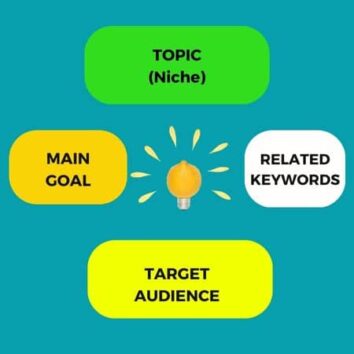
Catchy blog names are names that are memorable, grab attention, and immediately give readers an idea as to what the blog’s content is about.
A catchy blog name gives a strong first impression, making the reader curious. It also makes the blog stand out from the crowd.
A good blog name is easy to remember and share. So it can help to make the blog more visible on the internet so it can reach more people.
So when you choose a blog name, pick one that will make your blog more successful by drawing in more readers. This may also help you build a brand more quickly.
The question is how to come up with the perfect catchy name for your blog. Here are a few simple things you can do:
1. IdentifyYour Blog Niche
The first step in choosing catchy names for blogs is to define the blog’s niche.
Your niche is the central theme of a blog. This is important because should be a connection between a catchy blog name and what the blog is about.
- Identifying Niche Keywords: You can use keyword research tools to identify niche-specific keywords that can be used in your domain name. This will help your blog rank better in search engine results pages.
- Brainstorming Catchy Blog Names Ideas: Once you have identified your niche and main keywords, brainstorm catchy blog names that represent your blog’s theme.
So, if your blog is about cooking, your catchy blog name should be related to cooking.
Disclosure: This article may contain affiliate links. It means if you buy something after clicking a link on the page. I may receive a small commission. It doesn’t cost you anything extra. Thank you!
2. Do Keyword Research for Blog Names
Keyword research is an essential step in choosing a catchy name for your blog. This involves finding relevant keywords that you can include in the name.
Here are some key things to keep in mind when you research blog names:
Use Keyword Research Tools: Keyword research tools help you identify those keywords that your target audience commonly enter when they are searching the web.
- Choose Relevant Keywords: Relevant keywords are are those keywords or phrases that related to your niche.
Keep your domain name under 15 characters. Longer domains are harder for your users to remember”- WP Beginner
3. Brainstorming Techniques
Brainstorming can be a challenging process. But there are tools available that will make it easier for you.
A few popular brainstorming techniques are Mind Mapping, Reverse Engineering, and Thesaurus Exploration.
Mind Mapping
Start with one main idea (such as your niche or brand identity) and branch out with related words and phrases.
You can generate new ideas and connections from there.
Reverse Engineering
Look at successful blogs in your niche and analyze their domain names.
You will get ideas for similar or alternative catchy blog names that may work for your blog.
Thesaurus Exploration
Use a Thesaurus to look up synonyms and related words for keywords that are relevant to your blog.
This can help you to find unique and creative blog name options.

4. Use Blog Names Generators
Another way to find useful and catchy blog names is by using software that generate blog names.
You simply enter your “seed” keywords and follow the prompt and the software will generate blog names that may be catchy and fun.
Popular Blog Name Generators
These are five popular blog name generators: Wordoid. Domain.Com, Panabee, Name Mesh, and Name Boy.
These are just a few of the blog names generator tools that are available.
Once the tool generates a list of names, go though and pick the ones you like. However, don’t get distracted by those “cute” names.
Remember your goal is to pick the best name for your blog.
The next step is to go to a domaim name registrar to check whether the blog name you like is available.
Catchy Blog Names Examples
This is a list of 10 auto generated catchy blog names. Take note of how the main blog tops is incorporated in each one.
| Blog Niche | Catchy Blog Names |
|---|---|
| Food | Bite Me Blog |
| Fitness | Sweat Equity |
| Travel | Roaming Roadsters |
| Personal Development | Rise and Thrive |
| Beauty | Glam Guru |
| Fashion | Chic and Trendy |
| Technology | Wired Wisdom |
| Business | Hustle and Grow |
| Lifestyle | Balanced Bliss |
| Parenting | Little Learners Lounge |
5. Choose the Right Domain Extension
There are many different domain extensions available, but not all are suitable for blogging.
A few popular domain extensions for blogging include .com, .net, and .org.
However, there are also country-specific domain extensions (such as .uk or .au) and new and unique domain extensions (such as .blog or .co).
Common Domain Name Extensions
.com: mainly used by commercial ventures
.net: also used by businesses and personal projects
.org: used by non-profit organizations
.edu: generally associated with educational institutions
.biz: attached to company names
.aero: used by the aerospace industry
.post: reserved for the post office
.gov: used by governmental entities
.mil: restricted for use by the military
.museum: used by museums and relevant entities
Some factors to consider when choosing a domain extension include:
- Popularity: Stick to a popular domain extension, such as .com, if possible.
- Country-Specific: Use a country-specific domain extension if your blog is targeted to a specific country or region.
- New and Unique: Consider a new and unique domain extension if you want to stand out and be memorable.
6. Incorporate Branding In Your Blog Name
Your domain name is a key part of your blog’s branding, so it’s important to incorporate branding into your domain name.
This means defining your blog’s brand identity and choosing a blog name that reflects that identity.
7. Check For Availability and Trademarks
Before finalizing catchy blog names, it’s important to check its availability and ensure that it doesn’t infringe on any trademarks or intellectual property rights.
You can use domain name availability checkers and trademark search tools to do this.
This is to ensure that you are not using copyrighted material (such as brand names or slogans) in your blog name.
Registering Your Domain Name
Once you have done all the work to ensure that the catchy blog name you chose is available, its time to register it.
Choose a reputable domain registrar (such as GoDaddy, Domain.Com or Namecheap) and follow their registration process.
Some tips for registering your domain name include:
- Choosing a Reputable Domain Registrar: Choose a registrar that is reliable and has a good reputation.
- Understanding Domain Name Registration Fees: Understand the fees associated with registering a domain name, including registration and renewal fees.
- Tips for Registering Your Domain Name: Consider registering your domain name for multiple years to save money and ensure that it doesn’t expire.
Domain Registration Costs
What Costs To Register A Domain? It only costs about $9 to $15 dollars (US) to register a new domain for a year.
And the domain name is all you need to purchase to start your amateur blog. Ignore the addons.
Your hosting provider may offer free blog names, however, I recommend you register your own with a reputable Domain Registrar.
In the event you need to part company with your hosting provider, there will be less of a hassle.
Summary
Now you have some guidelines on how to choose catchy blog names for your amateur blog. These are a few thing to keep in mind when deciding on a name for your blog:
- Keep the domain name short.
- Choose a name that your users will easily remember
- Go for a domain extension that is relevant to your project.
- Do not include special characters in your blog name.
- Avoid using numbers.
Remember your main goal is to provide a great user experience. And so you want to ensure that your catchy blog name is search engine friendly. But most of all you want it to be user friendly.
Now it’s time to find a home for your amateur blog. Next stop is web hosting.

